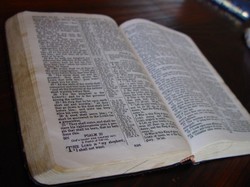Writing a book is easy, compared to finding a publisher for it - wrong! First of all, writing a book is NOT easy, second, it takes time, lots of time. Finding a publisher on the other hand is very easy and it is even easier to get your manuscript accepted by said publisher. And if I now tell you that this publisher is the absolute market leader when it comes to selling books? Enters Amazon ... 'But, but, but, Amazon is a bookseller, not a real publisher, you are just self-publishing!' More or less true. The reasons why I choose to (self-) publish my book on Amazon and not even looked at finding a 'traditional' publisher are outlined below. Just have a look at the following 'Amazon versus Traditional Publishing' sections and choose the topic you are most interested in:

Why I published my first book on Amazon - and you should too ;-)
by Sam
I finally followed my own good advice, wrote my first book and published it on Amazon. Why Amazon and not a traditional publisher? Read on to find out ...
This my book btw ;-)
 |
| Pilgrim Tips & Packing List Camino de Santiago: What you need to kn... |
Some Hard Facts and Numbers
- Amazon states that Kindle books outsell 'dead tree' books 3:1, most likely because they are not only cheaper, but also available in minutes, not days.
- Amazon stated September 2012 that 27 of its Top 100 Kindle books are by independent authors.
- Traditional publishing pays its authors between 10-15% in royalties, usually once or twice a year.
- Amazon pays its authors between 35-70% royalties, monthly if you hit payout level and within 60 days in arrears.
- On Amazon you can set your own prices, a traditional publisher will decide that for you.
- Compare: Amazon book sells for $2.99 and you get 70% royalty which equals $2.00 royalty for you (Amazon keeps a few cents to offset digital storage and download costs).
- A traditional publisher sells your book for $9.99 and you get, let's be optimistic, 15% royalty which equals roughly $1.50.
- Not only do you get less royalties, your readers also pay more for your books published by a traditional publisher.
Below are two links to 'Amazon Success Stories'. Just bear in mind that not everybody can and will achieve that amount of success, but most of us will be happy with a few hundred extra $$$ ;-)
Amazon Stories
... the good and the ugly!
From Manuscript to printed book
With 'traditional' publisher, I mean the classic print publishers, who were, until a few years ago, the main road to getting your book on the market. Let's completely forget about vanity publishing where you have to pay somebody to print your book and then do the marketing legwork yourself!
Traditional Publishing: For the sake of simplicity let's assume that you and I are authors that are both unknown and are not any 'world class' experts on the subject. For such an author, the way to find a traditional publisher goes like this:
- Finish your book or, alternatively, finish a 'presentation package' with outline, sample chapter(s), covering letter etc.
- Find out addresses of publishing houses that cover your subject and might accept books / manuscripts / book proposals by unknown authors.
- Alternatively find a literary agent to represent you and take a share of your sales later on.
- Find out exact address and submission guidelines, submit manuscript.
- Wait, normally several months, until somebody comes back to you and says 'Yes', 'No' or 'Maybe' to your book. Mostly it will be a 'No' ...
- If it is a 'Yes' or 'Maybe', negotiate contract, change what needs changing in the manuscript and wait until your book is finally edited, layouted, printed, ready to be sent out and, hopefully, sells.
This whole process, from first proposal to first sold book can easily take 12-18 months, or even longer. And forget about advance payments, it is very, very rare that a new author receives any of these nowadays. Royalties, depending on your contract, are also paid only once or twice a year - so you see, between finishing your book and seeing any financial reward from your hard work can pass a long time, normally years!
Compare this to Amazon:
- You finish your book, convert it into two different formats, one for print and one for Kindle, upload the two to Amazon and wait until they are proofed and ready for sale.
- Hit 'Publish' in your Amazon dashboard(s) and they are soon available all over the world for sale.
With my first book it took me approximately one week for the whole process, from after I finished the manuscript to published, ready-to-sell book. Next time this will be quicker, as I know now what to do ;-) And yes, I had the first sales a few days after I hit the publish button, both in print and as Kindle versions.
But a REAL Publisher will help me marketing my book!
Keep dreaming! Do you know how many books Bloomsbury, the original publisher of the Harry Potter series, of 'Harry Potter and the Philosopher's / Sorcerer's Stone' printed as a first run? 500! Yup, that is all - they had to run the next one rather quickly! That is what happens to new and unknown authors in the 'real publishing' world.
Now comes the hit, as J.K.Rowling finished her first adult fiction novel, the initial print run was, drum-roll please, 2 Million copies in the US! That is what happens to you when you are a worldwide known author, even if you completely change genre.
What you realistically can expect from a traditional publisher is a small test print run, most of those books will go to libraries, others will go to booksellers for them to read and hopefully recommend the book to their customers and a few will go to professional book critics in the hope they find the time to write up some nice words about it - some when. That is pretty much all what a traditional marketer will do for an unknown author, until the first real sales kick in. If you show then bestseller sales potential they will treat you to the whole shebang and organize book reading and signing events for you.
There is one exception to this rule. This exception is academic works, reference books and the like written by already established experts on the topic, read lots of titles and grades from an important university plus having already published papers and articles in peer-to-peer reviewed magazines. This kind of author can, because his / her name is already known in certain academic circles, expect to be more heavily promoted for example with more books sent to specialist book shops and libraries.
The dark side of traditional publishing
The bright side of self-publishing
Still need convincing?
Read this author's story on how and why a traditional publisher makes one of her books pay for the other without her getting much in royalties. She is now also going down the self-published road - no wonder!
Daily Mail on Self-Publishing - Don't tell my hubby please ;-)
My husband kills me if he ever finds out that I linked to the Daily Mail, but hey, this article really sums it up nicely!
How does Amazon then market my book?
You have to bear in mind that Amazon is not only a bookseller, it is also its own search engine! When I am looking for books on a certain topic, I go to Amazon and even when I search for something on Google, the results will include, more often then not, Amazon book listings if a matching book exists. So, if there is somebody looking for a book on a topic, they will end up sooner or later on Amazon. This is obviously easier to achieve for books that have a clearly defined topic, such as a non-fiction guide. Novels with their often beautiful, but little descriptive titles, have it a bit more difficult. They are often found if somebody goes through the different categories on Amazon and looks for new stuff to read.
But there is more; Amazon actively makes suggestions to customers which books they might also like, both by email and on the website. And there is the listing of 'customers who bought this book also bought ...' all this helps to cross promote books and other items internally on Amazon.
Additionally there is a possibility to give the Kindle edition of your book away for free for a few days. This can help with getting that elusive first review, better ratings etc. but that is enough material for another article.
The preview feature is another huge selling point, by clicking 'look inside this book' a potential buyer can read a short part of your book and see if content and style are what s/he is looking for.
Summary: By being the biggest bookseller in the world and having Amazon results in the Google search results, your book will be seen by a lot of potential buyers. Just make sure it is good!
But I can't {insert lacking skill here} and a traditional publisher will do that for me.
Yes, I admit, that can be convenient and if you have a huge project that requires a lot of layout work, clearing of rights and graphic design, a traditional publisher might well be your better choice. But most of us publish rather 'simple books', basically a manuscript and a cover is all that most books consist of. Here some ideas and work-arounds for the other necessary tasks.
Editing
Editing should be the first step any author does. It means reading the book with view on things like consistency, plot holes, loose threads in the story line and so on. If that is done, it is a good idea to pass your manuscript onto a few selected friends that like books of the same genre. Ask them to forget about things like typos and grammar. Ask them to concentrate instead on things like inexplicable change of hair color of a character, holes in the plot and general readability. If your friends are like mine and read a lot, finding volunteers shouldn't be too difficult.
Proof Reading
Don't do your own proof reading! Find somebody to do it for you. This can be a retired teacher or journalist. Just make sure it is somebody that knows the task of proof reading on a professional level. If you can't find somebody immediately, ask your friends if they know somebody. Professional proof reading costs money, but if you know the person well, you can offer a share in the potential sales instead of an upfront payment, that can keep initial costs down.
Cover Design
Yes, you can do your own, and it is not so difficult! In case of complete lack of ideas and skills you can outsource that step also. Again look around amongst family and (online) friends to find somebody. You can also try fiverr.com, some of the people there can be quite good. The basic things to remember are that your cover should stand out from the crowd, should show what your book is about and have a descriptive and catchy title.
Fellow Wizzley Author Lissie wrote this helpful book - recommended.
 |
| Kindle Nonfiction Formatting Guide: Solve Your Nonfiction Formattin... |
Converting to Kindle Formats
That was the bit that nearly killed me! And yes, it is a learning curve and also yes, you can do it yourself if you can follow instructions to the point. If you have extremely limited formating in your manuscript, basically just paragraphs and perhaps the odd word in bold or italics, then Amazon's own free guide will be sufficient. If you have more complicated formatting, like bullet points for example, I can recommend fellow Wizzley author Lis' book (see above) to you. She is also available, for a fee, for custom services when it comes to Kindle formatting, see her blog post >>>here<<<.
And last, but not least, you could do what I did and use 'Scrivener' to write and format your book. That is hands down the easiest way. Click on the nice little graphic below and try it out for free for thirty days! Yes, it has a learning curve, but hey, so has life also ;-)
Full Editorial Control and Responsibility
That one was the biggie for me! I not only wanted to write a book, I also wanted to decide on content and layout. But with this editorial freedom comes also a lot of responsibility. In the case of a non-fiction book like mine, I needed to check and double-check all the facts myself, make sure I have the right to included certain material like images etc. Double-checking facts is second nature for me and the second problem I avoided by using only my own material, including my own image for the cover.
In all cases, no matter if a fiction or non-fiction book, you also need to make sure that grammar, spelling and punctuation are as close to perfect as possible. For this part of the book creation I had help from a good friend, a retired journalist and copy-editor, who religiously proof-read the book, all 136 pages, not only once, but four times.
Summary: If you don't need the support of a big team for complicated layouts, clearing of rights, custom illustrations and proof reading / editing, publishing on Amazon is perfectly feasible for you. And even if you need some support regarding this, it might still be better to outsource certain tasks, then to hand over your book to a 'real publisher' and exchange your editorial freedom for 'editorial security'.
A song to Inspire you!
You might also like
How to Write the First Line in FictionIt is the worst of lines, it is the best of lines. That all important first l...
Putting Words in Their Mouths | How to Write Good Dialogue in ...There are many ways that a good story can be ruined, bad dialogue is one of t...




 How to Choose the Topic for your First Bookon 12/17/2012
How to Choose the Topic for your First Bookon 12/17/2012
 What to do with Kids in Prague - Go To the ZOOon 10/30/2012
What to do with Kids in Prague - Go To the ZOOon 10/30/2012
 Choco Story Museum - Things to do with Kids in Pragueon 10/30/2012
Choco Story Museum - Things to do with Kids in Pragueon 10/30/2012
 Sodom and Gomorrah- What does the Bible say about homosexuality?on 10/02/2012
Sodom and Gomorrah- What does the Bible say about homosexuality?on 10/02/2012



Comments
You are welcome, feel free to come back to me with any questions you might have;-) SY
Nice to meet another author here ;-) Give me a shout if you need any help, SY
I've just published on Amazon Kindle - quite a challenge to figure out the formatting. Think I'll check out some of your suggestions before my next one!
Glad to hear that, Sara, shoot me a note if you need any help! SY
Thanks for the inspiration. I have a book I have been wanting to write and publish with Amazon. I think you just nudged me!
Glad to hear that Rebecca! I wish you many book sales ;-)
great job and all told-- it was about the same experience for me as well.
Thank you both for your kind words! Glad you found it helpful ;-) SY
Very interesting and very helpful - thank you :)
@brl + frugalrvers
Just do it ;-)